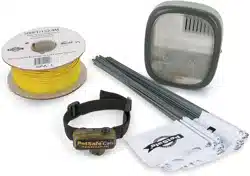Loading ...
Loading ...
Loading ...

www.petsafe.net 11
Width Control knob clockwise increases
the Boundary Width while turning it
counterclockwisedecreasesit(6B).Repeat
this activity as needed until the Receiver
Collar beeps at the desired distance from the
Boundary Wire.
The numbers on the Boundary Width Control
knob indicate signal strength and are not
representative of Boundary Width footage. If
adjusting the Boundary Width Control knob
Boundary
Wire
Boundary
Wire
6D 6E 6F
does not give the desired range, adjust the Boundary Control Switch to another setting to achieve your desired range. If
using a Double Loop, you may need to increase the separation of the Boundary Wire to achieve desired range.
The Receiver Collar beeps as a warning tone and ticks when delivering a Static Correction. After hearing the beep,
continuetowalktowardsthewire.TheReceiverCollarshouldtickandtheTestLightshouldash,indicatingthe
StaticCorrectionasyouentertheStaticCorrectionZone(6F).AwarningtoneandtheashingoftheTestLight
indicate that the Receiver Collar and the system are working properly. Test in a number of different areas until you
are satisfied that the system is functioning properly. Next, walk all around the Pet Area to ensure there are no areas
where the Receiver Collar may activate from signals coupled onto buried wires or cables. Test the collar in and
aroundtheinsideofthehouseaswell.Asmentioned,cableandwiresfromcableTV,electricalortelephonelines
may conduct pet fencing signals inside and outside the house that can activate the cat’s collar accidentally. While
rare, if this occurs your Boundary Wire is probably too close to these outside lines and should be moved or modified
as shown in Figure 3A.
If you are satisfied that your system is functioning properly, you are ready to start burying the Boundary Wire. If the
ReceiverCollardidnotbeeportheTestLightdidnotash,seethe“Troubleshooting”section.
Note: The Boundary Width is broken down into 20% Warning Zone and 80% Static Correction Zone.
____________________________________________________________________________________________________
Install the Boundary Wire
To Bury the Boundary Wire
Burying the Boundary Wire is recommended to protect it and prevent disabling the system.
1. Cut a trench 2.5-7.5 cm (1-3 in.) deep along your planned boundary.
2. Place the Boundary Wire into the trench maintaining some slack to allow it to expand and contract with
temperature variations.
3. Use a blunt tool such as a wooden paint stick to push the Boundary Wire into the trench. Be careful not to
damage the Boundary Wire insulation.
To Attach the Boundary
Wire to an Existing
Fence
The Boundary Wire of the PetSafe
®
In-
GroundCatFence
™
can be attached
to a chain link fence, split rail fence,
or a wooden privacy fence. The
Boundary Wire can be attached as high
as needed. However, make sure the
Boundary Width is set at a high enough
range for your cat to receive the
signal. If using a Double Loop with an
existingfenceatleast1m(3ft)tall,run
the Boundary Wire on top of the fence
and return it on the bottom of the
fencetogetthe1to1.5m(3to5ft)
STAPLE WIRE TO FENCE
WEAVE WIRE INTO FENCE
STAPLE WIRE
TO FENCE
7A
(3-5 ft)
1-1.5 m
(3-5 ft)
1-1.5 m
SINGLE LOOP
DOUBLE LOOP
7B
separation needed.
Step
7
Loading ...
Loading ...
Loading ...
